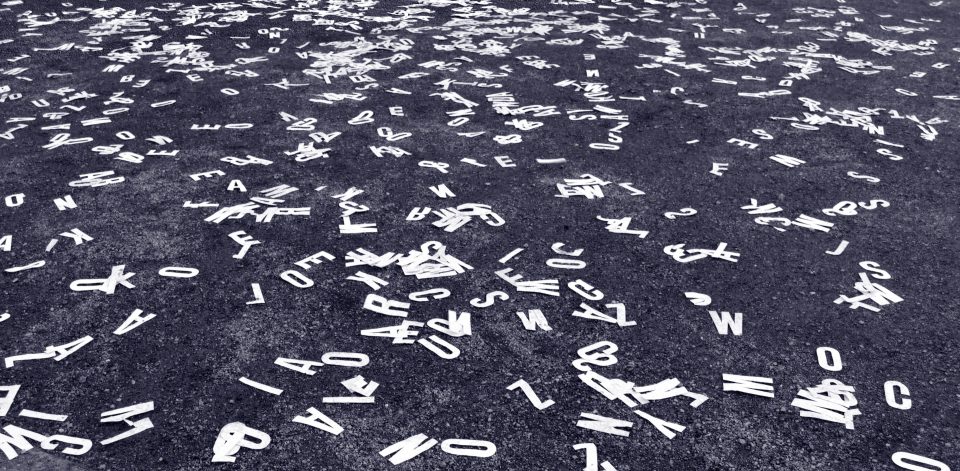
By CDH Guest Author on April 5, 2016
“Hypermaterializing Posthuman Poetics” is a practice-based investigation into the use of meta-data structures for conducting and presenting literary criticism. In order to conduct this investigation, I am building multi-modal models of selected poems by Susan Howe – a language-oriented American poet who enacts her feminist politics through notoriously difficult poetry. This difficulty stems – in large part – from a poetic allusiveness to hidden, erased or otherwise silenced narratives (often belonging to women) from throughout America’s history that Howe has uncovered in various archives around the country. These recovered narratives speak through Howe’s poetics, which, in an effort to avoid their own subsequent erasure by history, resist editorial and typographical norms, a poetic practice that makes reading, itself, a challenge (consider the image: a page from her poem “Thorow”: http://wings.buffalo.edu/epc/authors/howe/thorow.html). These poems almost require the intervening voice of a literary critic to offer potential ways to understand them and find meaning. Because of the integral relationship between primary and secondary texts that these poetics engender, they present a particularly fruitful zone from which to explore the affordances of meta-data structures as they relate to data objects for literary criticism. In this formulation, the primary text (Howe’s poetry) becomes the data object, while the secondary texts (the interpretive, critical scholar’s analysis) become the meta-data structure through which to access, process, and understand the original (primary) data (textual) object.
Using this data-object / meta-data relationship, I will build dynamic databases of selections of Howe’s poetry. As they structurally perform the relationship between primary and secondary text described above, these databases will enrich readers’ experiences of these poems by integrating the critical interpretive information directly into the literary object so that it becomes an integral part of reading this poetry. In many ways, then, the databases are analogous to what, in traditional literary critical writing, would be called the literature review, since they will contain information on multiple critics’ interpretations of Howe’s texts. At the same time, these databases will be objects of literary criticism in their own right, as they will have been designed and populated through my own critical, interpretive lens; it is in this capacity that this project expands compositional possibilities of digital technologies for not just conducting, but also presenting literary criticism.
“Hypermaterializing Posthuman Poetics” marks the beginning of a much larger, theoretical investigation in the politics and poetics of meta-data, structures that are simultaneously cultural, ideological, and technological. This investigation specifically asks if meta-data politically aligns with postmodern meta-narrative or the cultural master narrative that meta-narrative explicitly works against. As data that describe data, meta-data could be analogous to narrative that describes narrative; as rigid, encoded structures that cannot be worked against, they could be more analogous to a master narrative. As the linked image of “Thorow” above demonstrates, the insistent self-reflexivity of Howe’s poetry, which actively resists its readers’ ability to forget the poetic object itself and become immersed in the writing, is very much in line with postmodern meta-narrative, which mobilized similarly self-reflexive poetics. Interpreting her poems through meta-data structures, then, is (as well) an experiment in theoretical practice from which to begin thinking through the politics of meta-data.
The first days of the Metadata Central Kickoff Workshop have already been invaluable to conceptualizing the design of this project. Hearing my workshop peers’ articulations of their own projects in terms of how the back-end meta-data structures interact with its front-end interface design has been particularly helpful, in large part because of the ways my own project contrasts with theirs. Where many of these projects have stressed the importance of the back-end design, noting that the front-end can be clunky or “ugly” as long as the back-end functions to make the information it contains accessible, my project will not have such an easy separation of front- and back-ends. This is a result, both of the project’s self-reflexive focus on aesthetics and poetics, and of project’s basis in methods of reading – a front-end, information processing activity. At the same time, the practical conversations with library, archive, and museum professionals who deal with both digital and analog meta-data structures on a regular basis has clarified a great deal of the technological limitations behind meta-data structures, which have in turn complicated the “easy” delineation of meta-data as either a meta-narrative or a master narrative structure. This complication directly affects the theoretical question at the heart of this project, and points toward a need to revise my own views of meta-data’s relationship to meta-narrative: if this relationship is not a clean either/or, perhaps it needs to become a both/and, a multiplicity rather than dichotomy. Embracing this multiplicity, perhaps, further prompts a reassessment of the relationship between meta-narrative and master narrative, between ideology and poetics of resistance.
Image courtesy of Nikko on Pixabay: https://pixabay.com/en/letters-typography-design-art-type-651716/. Dedicated to the public domain under CC0 1.0 Universal terms.
The Metadata Central project was supported in part by funding from the University of California Presidential Faculty Research Fellowships in the Humanities, MR-15-328710.
Sarah Whitcomb Lozier is a PhD candidate in the English department at UC, Riverside, where she is completing a dissertation entitled “Hypermaterial Language Art: Digitality, Materiality, and Contemporary Anti-Racist Poetics.” Specializing in contemporary visual and digital artworks, as well as 20th-21st century American poetry, her research uses theories of digital materiality as a critical lens through which to access the anti-racist poetics at the heart of linguistically experimental works of art. She has presented elements of this research at various conferences, including the American Studies Association annual conference and the Society for Cinema and Media Studies annual conference, and has a case study examining contemporary forms of digitally-mediated activism through the #MyNYPD hashtag forthcoming in Civic Media: Technology, Design, Practice (MIT Press, 2016).
